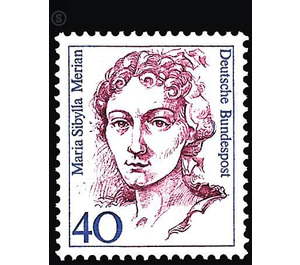Postage stamp: Women of German History - Germany / Federal Republic of Germany 1987 - 40 Pfennig
Theme: Health & Human
| Country | Germany / Federal Republic of Germany |
| Issue Date | 1987 |
| Face Value | 40.00 |
| Color | white violet |
| Perforation | K 14 |
| Printing Type | 2-color Typography |
| Stamp Type | Postage stamp |
| Item Type | Stamp |
| Chronological Issue Number | 1204 |
| Chronological Chapter | GER-BRD |
| SID | 617184 |
| In 53 Wishlists | |
The new series »Women of German History« is intended to help raise awareness of women's achievements in society. Of the new postage stamps, the 40 Pf value will be published in the issues "Deutsche Bundespost" and "Deutsche Bundespost Berlin", the 60 Pf value only in the issue "Deutsche Bundespost". Maria Sibylla Merian was born in April 1647 in Frankfurt am Main. Her father was the famous painter, engraver and publisher Matthew Merian. From an early age, Maria Sibylla's artistic talents must have become clear, so that her father should have said: "If I'm not there anymore, one will say: This is Merian's daughter." In June 1650, Matthew Merian dies unexpectedly. After a while, the mother married the painter Jacob Marrel (also: Moreel and Marreel). He deserves the great merit of having early recognized the artistic talent of his stepdaughter and promoted it as far as possible. He taught Maria Sibylla in painting and also gave her his student Abraham Mignon as a teacher. From both, she learned the exact observation of the surrounding small world and the subtlety and technique that characterized Dutch painting of the 17th century. Maria Sibylla Merian had quickly become an artist. In May 1665, Maria Sibylla married the Nuremberg painter Johann Andreas Graff at the age of 18. Maria Sibylla Merian did not take her father's name, because under him she had become famous. Maria Sibylla Merian is thirty-two years old, when in 1679 the first volume of her three-part work »The Caterpillar Wonderful Transformation and Strange Flower Food« (as in the title copper for the 1st volume) appears. This was preceded by numerous flower and insect studies. In 1685, Maria Sibylla moves Merian to the Netherlands. A scholarship from the city of Amsterdam makes the long-cherished wish for a trip to Suriname come true. Maria Sibylla Merian publishes the impressions of the variety, exuberance and splendor of flora and fauna in the work, written in 1705, with the Latin title "Metamorphosis insectorum Surinamensium". The work receives great recognition; Her name went through the whole educated world. Recognized worldwide, Maria Sibylla Merian died on January 13, 1717 in Amsterdam.


